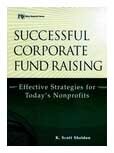Successful Corporate Fund Raising: Effective Strategies for Today's Nonprofits
How can we find out information about corporations and their giving histories? Who makes the funding decisions in these companies and how do we cultivate relationships with them? Are there any hidden pitfalls and, if so, how can we avoid them? These are questions asked by many nonprofit organizations, recognizing that companies are an increasingly important source of funding (in 2001 corporations gave a total of $9.05 billion). Although many fundraisers, both new and experienced, are eager to tap into these resources, they are hindered because they don't understand corporate funders and how they operate. In Successful Corporate Fund Raising, K. Scott Sheldon, a fundraiser for educational institutions for twenty-five years, has provided us with an introduction to the world of corporate giving with in-depth discussions of the five major aspects of successful fundraising: background and philosophy, types of support, the process, the people involved, and strategy.
Sheldon begins with an overview of corporate giving, including a comparison of corporate foundations and direct corporate giving programs. He briefly discusses the motivations behind charitable donations, reminding us that the seeds for a more proactive approach to corporate philanthropy were sown in the 1970s — a surprise for those who think of this as a relatively recent phenomenon. Next follows a survey of the different types of funding, from cash grants to matching gift programs to in-kind support to corporate volunteerism, with explanations of why a funder may prefer one type to another. In addition, Sheldon spends some time discussing cause-related marketing, an important source of corporate dollars in recent years.
The section on process begins with an overview of the various print and electronic resources available for researching individual companies, and continues with advice on building relationships and preparing proposals. Fundraisers will appreciate the tips on making "the ask," maintaining donor relationships, and evaluation. Sheldon points out the importance of evaluating not only the success of the agency's project (most funders will require this) but also the success of the agency's solicitation techniques.
"The best process will ultimately fail without adding the human element to the equation," asserts the author. With that in mind, fundraisers new to the corporate scene will appreciate his advice on identifying and cultivating the decision makers in companies who can serve as points of entry and empowerment for nonprofits. In the final section, Sheldon discusses the importance of creating and implementing an effective strategy for fundraising, beginning with the setting of realistic, achievable goals and then implementing the strategy through a written plan of action. To illustrate, he takes the reader through a step-by-step case study focusing on employee matching gifts. Along the way, he identifies and discusses practical issues surrounding matching gift programs, such as volunteerism as an incentive for matching, applying the matched funds, and the timing of gift distributions.
Numerous charts and tables accompany the text, highlighting and clarifying the discussion. A sample corporate proposal is included, with examples of the documents that might be included in a proposal appendix, such as a determination letter, annual budget, Form 990, endorsements, and staff biographies.
A word of caution: this book is intended essentially as a corporate fundraising primer, and the information provided, although invaluable, is basic. You will not, for instance, find analytical case studies of nonprofits that forged successful relationships with corporations, though the inclusion of one or two would have been helpful as illustrations of important points. Still, Successful Corporate Fund Raising can serve as a handy manual; its practical, hands-on approach will prove useful to those who seek to launch and maintain a successful corporate development program.
For citations to additional materials on this topic, refer to Literature of the Nonprofit Sector Online, using the subject heading "Fundraising-corporate philanthropy."








